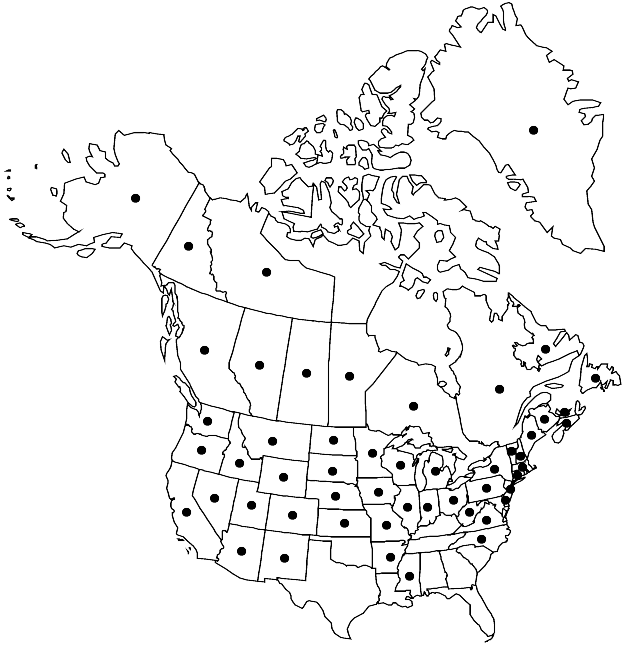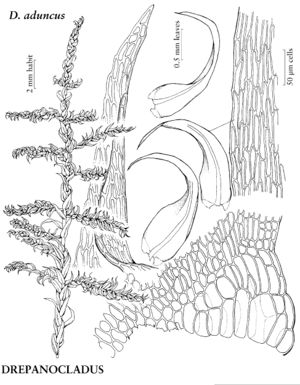Drepanocladus aduncus
Beih. Bot. Centralbl. 13: 400. 1903.
Plants small to large. Stems pinnate or irregularly pinnate. Stem leaves falcate or sometimes straight, ovate-lanceolate, ovate, triangular-ovate, rounded-triangular, or broadly ovate, gradually narrowed to apex, concave, 0.9–5.1 × 0.4–1.6 mm; base erect to erectopatent, insertion slightly curved; margins entire or occasionally very finely denticulate; apex [obtuse] acute, or short- to long-acuminate, acumen gradually differentiated, in straight-leafed plants plane or at most weakly furrowed; costa single to mid leaf or beyond, ending well before apex; alar region transversely triangular, reaching from margin to costa or almost so; ratio of medial laminal cell length (µm) to leaf length (mm) 17.9–35.5 (very rarely to 38.2). Sexual condition dioicous.
Habitat: Mineral-and nutrient-rich wetlands, eutrophic fens, shores, ditches, submerged in pools and lakes, swampy forests
Elevation: low to high elevations
Distribution

Greenland, Alta., B.C., Man., N.B., Nfld. and Labr., N.W.T., N.S., Ont., P.E.I., Que., Sask., Yukon, Alaska, Ariz., Ark., Calif., Colo., Conn., Del., Idaho, Ill., Ind., Iowa, Kans., Maine, Mass., Mich., Minn., Miss., Mo., Mont., Nebr., Nev., N.H., N.J., N.Mex., N.Y., N.C., N.Dak., Ohio, Oreg., Pa., S.Dak., Utah, Vt., Va., Wash., W.Va., Wis., Wyo., Mexico, West Indies, Central America, South America, Eurasia, Africa, Indian Ocean Islands (Kerguelen), Pacific Islands (New Zealand), Australia.
Discussion
Drepanocladus aduncus is most likely to be confused with 2. D. polygamus; the differences between these two are discussed with the latter. Drepanocladus aduncus is frequently also confused with Sarmentypnum or Warnstorfia (Calliergonaceae) species, but the latter frequently have red colors when growing in exposed habitats, whereas D. aduncus never becomes red. Rhizoid initials are almost invariably found near the apex of at least some leaves of most Sarmentypnum and Warnstorfia species (rare only in S. trichophyllum); leaf-borne initials are never found in Drepanocladus.
Because Drepanocladus aduncus is variable in habit, several taxa have been segregated from this species. The phenotypes most frequently recognized at the species level were small plants with short laminal cells and weak costae called D. polycarpus, large plants with long laminal cells and strong costae called D. aquaticus or D. stagnatus, and intermediate plants called D. aduncus. Specimens with acute or sometimes obtuse leaf apices were called D. simplicissimus or Calliergidium bakeri, but these sometimes have typical D. aduncus leaves in some parts of the stems, and typical D. simplicissimus leaves in other parts. The studied two isosyntypes of Hypnum kneiffii var. filiforme S. Berggren consist of the species D. aduncus, D. sordidus, and Scorpidium cossonii.
Selected References
None.
